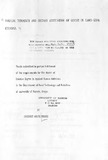| dc.contributor.author | Tirore, CA | |
| dc.date.accessioned | 2013-05-12T11:37:00Z | |
| dc.date.available | 2013-05-12T11:37:00Z | |
| dc.date.issued | 1998 | |
| dc.identifier.citation | Master of Science in Applied Human Nutrition | en |
| dc.identifier.uri | http://erepository.uonbi.ac.ke:8080/xmlui/handle/123456789/22489 | |
| dc.description.abstract | A croa-seclional sludy which was descriplive and analylical in nalure was conducted in
1997 among elementary school children age 6-18 years and bolh their biological parenls
in Kucha and Gofa-Zuria woredas. Came-Cola. Ethiopia. The study aimed at assessing the
familial tendency and dietary association of goitre. The investigation comprised clinical
examination for goitre. collection and laboratory analysis of water and urine samples and
inlerviewing of molhers about foods eaten and about goitre history of grand parents of
the children.
A total of 1791 subjects of which 597 were school children and the rest their
corresponding biological parents. were selected from seven schools of two woredas by
systematic random sampling method.
Prevalence of goitre in the study population was found to be 51.7% of which 21.7% was
visible goitre. Goitre ratio belween parents (falhers: mothers) was 2:5 for parents age
group 20-45 years, and 2:9 for those 46 years of 'age and above.
Familial tendency of goitre between parenls and their children was strongly significant.
Level of association of goitre was slronger between mothers and their children (p< 0.0000
and Odds Ralio = 13.08) than fathers and the children (p<O.OOl and Odds Ratio = 4.27).
Halleko (JIori/lffa s/e/lope/aJa) was commonly consumed as leafy vegetable in the study area.
and those who consume halleko more lhan two times
XVlI
per day were found to have high prevalence of goitre than those
who consume less than two times per day (p<O.005).
Laboratory results indicate that the mean urinary iodine excretion level was greater than
9 }..lgl/dL in almost all study groups which showed that the study group had adequate
dietary intake of iodine. The results also showed that other factors besides iodine
deficiency were playing role in goitre causation.
Laboratory analysis showed that drinking water was contaminated with E.coli and coliform
micro-organisms to the level which could be considered unfit for human consumption.
However, the relationship between microbial load in the drinking water and the goitre
prevalence was not signi ficanl.
The results therefore indicate that the prevalence of goitre in Carne-Cola. Ethiopia was
due to hereditary as well as dietary factors.
It is recommended that further investigations be carried out to elucidate the role played
by both dietary factors and familial tendency in goitre prevalence. Appropriate action is
also required to revitalize and effect the inlrrupled IDD control progamme in the country
so as to reduce the prevalence of goitre in the study area and country as a whole | en |
| dc.language.iso | en | en |
| dc.publisher | University of Nairobi | en |
| dc.title | Familial tendency and dietary association of goitre in Gamo-Gofa, Ethiopia. | en |
| dc.type | Thesis | en |
| local.publisher | Department of Food and Nutrition Technology | en |

